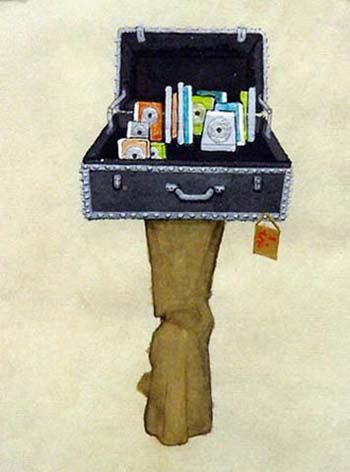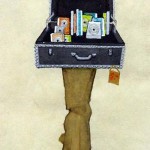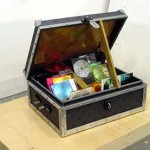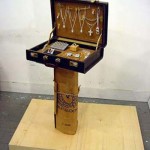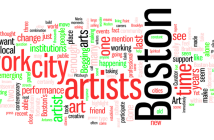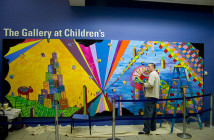Copying something creates a fake. Creating that fake object can be quite simple, you need only find an original and copy it, bearing in mind that he closer the semblance to the original, the more difficult the task of copying. Trying to create a fake without an original, however, is essentially impossible—the very concept of fakeness necessitates an original.
With his recent work, Boston based artist Alfredo Conde achieves this idea. His show, "Cheappy Cheappy Good Stuff" at AS220's gallery in Providence included works that were demonstrations and sketches of the sales stands, including products, of the counterfeit watch and jewelry market of Chinatown in New York. In a tongue in cheek description of his work one could say they are fakes without originals in that they are indeed copies of copies, but the works are actually representations of fakeness.
Alfredo became interested in the street vendor of Chinatown and began studying their culture and systems of survival by observation and discreetly held digital camera. All of this is much to his wife's concern as he could easily find himself embroiled in a rather treacherous misunderstanding if detected, especially considering the recent relegation of contraband products to terrorism. He's been so lucky as to take away an integral part of street vending paraphernalia, the up-up cardboard stand the vendors use to place the cases of their products on for display. He actually uses this stand in his own works. Alfredo insists he's there as an observer, not to invade or become a part of the counterfeit vending culture. From his detailed descriptions of the vendors, however, it seems as though he could compose a short ethnography on them. The vendors are a compelling subject, watch sales alone puts them at the end of a $9 billion illegal market with the losses to watch industry estimated to be $630 million a year.
His sculptural works are comprised of the suitcases that the sellers use for both transport and display cases, which he built out of the popular modeling material, foam-core, with packing tape and Velcro. For practical and aesthetic purposes, the suitcases are functional—they can be closed and gently transported. CD's (some real, some fake), costume jewelry, watches fashioned from foam-core and blings cut from cardboard (one of a hand-grenade, another of dollar-sign) are all products for show in Alfredo's suitcases. His paintings are matted on pieces of foam-core that look as though they were created by Alfredo to resemble the same display boards improvised by street vendors to sell their goods.
This re-creation of improvisation helps create the aesthetic that Alfredo strives for in these works, but his works are not improvisation: his materials are chosen with the same careful intent and the works constructed with the same apt deliberation as the designer of the display at the Rolex boutique. He is also not creating the object that the street vendors are indeed putting together in their improvisation. His work is somewhere in between the real and the fake, the actual and the improvised. Of course, his pieces and concepts are as original and fresh as an Alpen snowflake; he has found a way to articulate fake without an original.
When I first saw the images of the works online, I believed the suitcases to be real. The jewelry in the cases, though costume, could very well have been real "fake" jewelry, i.e. knock-off jewelry meant to seem real enough to impress a passer-by, but his jewelry of choice is costume jewelry. It is too fake and gaudy to be sold as 'legitimate' and fashionable wear (which is a rather extraordinary accomplishment considering the 'bling blings' of Chingy) but it suits Alfredo's needs for it to be one step outside the feigned authenticity of the street vendors merchandise. It seems as though Alfredo is trying just as hard to make his works seem fake as a counterfeit watchmaker is trying to make his product seem real. On the pricelist for "Cheappy Cheappy Good Stuff" the suitcase pieces are priced with their "product," the product being the watches, dvd's or jewelry. Describing those objects within the works as "products" helps balance out their apparent artificiality with a word that connotes legitimacy. In another witticism on the make believe, one of the works disappeared during the show and was listed on the price list as "Confiscated." As a matter of fact, billions of dollars of counterfeit goods are confiscated by various law enforcement entities all over the world.
The aesthetic he has created seems most tenuous when the objects he uses could actually be the same object they represent. When he does this the liminal fakeness created by representing the artificial, and standing as neither fake nor real, is pushed in the direction of tangibility. The fact that most of his sculptural works are made from foam-core, a rather ethereal material, keeps them in the realm of the pseudo, but the handle on one of the cases seems quite functional. The rolled-up cardboard stands are also quite usable—with a few slight modifications for durability, they may be quite usable for the purposes of street vending. These aspects of the work may indeed be "real" but they help illustrate the relativity of authenticity. The tactile qualities of some of the works are only foregrounds their oscillating point in the spectrum of bona fide and phony. The works do beg the question of what constitutes authenticity and where the limits of real and fake stop and end.
Let's not forget the Blonde Redhead album, "Fake can be Just as Good". We improvise where we cannot attain the original, as we've fallen prey to consumerism and iconography, we make every attempt to attain our ideal image, in so doing authenticity loses its priority to the desired image. Alfredo's work playfully takes advantage of the relativity of authenticity and has created works that demonstrate that very concept. His cases are fake, his models of counterfeit watches, also fake; but to the passer-by they are just as real as that Rolex I'm planning to purchase on my next trip to Canal Street.
- Brown Case with Bling
- Disc Case
- Drawing Disc Case
Links:
AS220
"Cheapy Cheapy Good Stuff" wass on view January 20, 2005 at AS220.
All images are courtesy of the artist and AS220.

